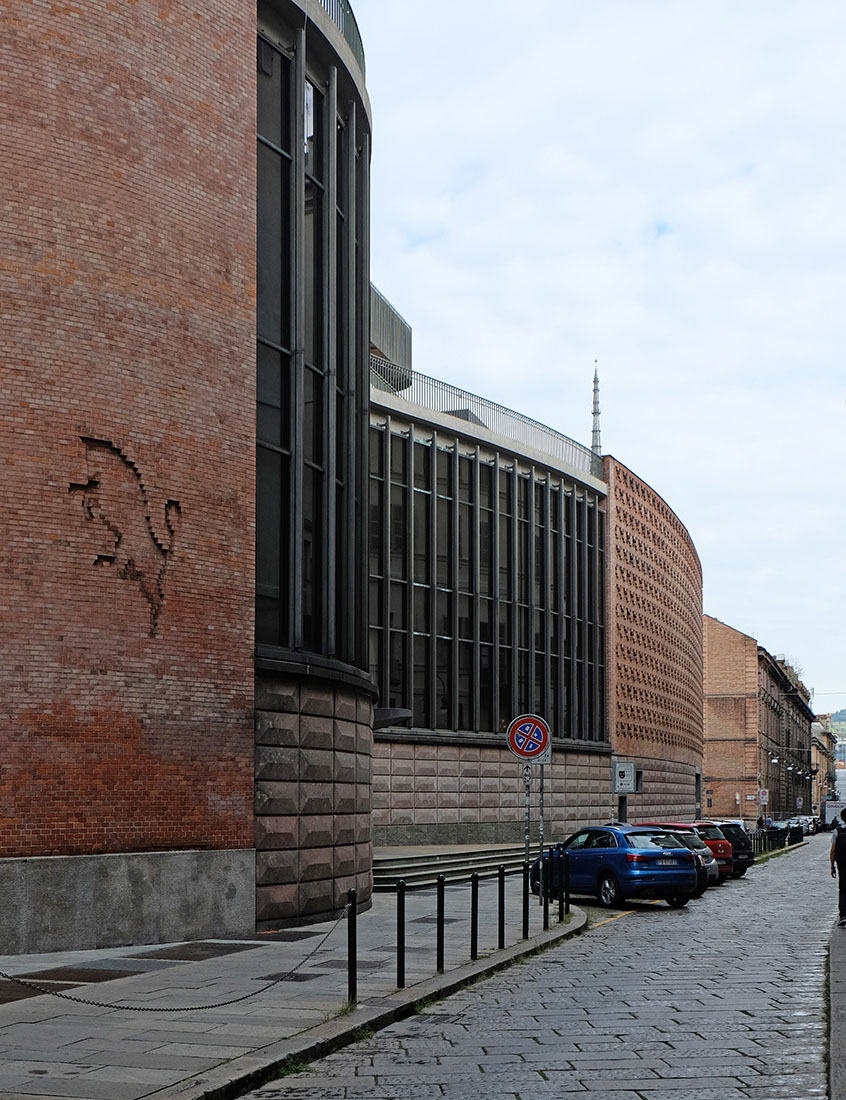 |
 |
 |
 |


Teatro Regio di Torino
Piazza Castello 215, Turin
1965 - 1973
The Teatro Regio di Torino is an opera and theater house in the center of Turin. The predecessor of today's Teatro Regio was built by the master builder Benedetto Alfieri according to plans by the architect Filippo Juvarra at Piazza Castello. After an eventful history, the building was heavily damaged by a fire on the morning of February 9, 1936. In the following year, an architecture competition for a new theater, which was to be equipped with the most modern technology, was carried out. The competition was won by Aldo Morbelli and Robaldo Morozzo della Rocca. However, the work on this project was delayed by the outbreak of the war. It was not until the mid-1950s that the city authorities of Turin decided to finish the theater. Without success, various committees were commissioned to evaluate and revise the draft of Morbelli and Morozzo della Rocca. Only in 1965 this situation was solved by commissioning the architect Carlo Mollino with a new project. Together with Carlo Graffi, the engineers Adolfo and Marco Zavelani Rossi as well as Sergio Musmeci, the work was resumed, and the preliminary project could be completed within four months. The working drawings were also completed within a very short time, but construction was not begun until 1967. The new building was reopened in 1973 with the performance of Giuseppe Verdi's opera Les vêpres siciliennes. The Teatro Regio is the best preserved building of Carlo Mollino and was renovated in 1997 by Gabetti and Isola.
The design by Carlo Maollino conceals the new theater from Piazza Castello. The facade to the piazza was completely rebuilt and became the main front of the theater. The newly designed part is separated from Alfieri's original structure and is only connected to it in two places. The entrance is from Piazzetta Mollino through the arcades to Piazza Castello. The curved walls contrast with the linear architecture of Filippo Juvarra. Further accesses are in the covered passageway. The atrium, visible from the outside, is a complex and impressive space. Various stairs and interior bridges lead the audience to the different entrances of the auditorium. The stairs are arranged around a central circulation core, which contains the elevators.
Das Teatro Regio di Torino ist ein Opern- und Theaterhaus im Stadtzentrum von Turin. Der Vorgängerbau des heutigen Teatro Regio wurde von dem Baumeister Benedetto Alfieri nach Planungen des Architekten Filippo Juvarra an der Piazza Castello erbaut. Nach einer wechselhaften Geschichte wurde das Gebäude am Morgen des 9. Februar 1936 durch einen Brand schwer beschädigt. Im folgenden Jahr wurde ein Architekturettbewerb für ein neues Theater, welches mit der modernsten Technik ausgestattet werden sollte, durchgeführt. Den Wettbewerb gewannen Aldo Morbelli und Robaldo Morozzo della Rocca. Allerdings verzögerten sich die Arbeiten an diesem Projekt durch den Kriegsausbruch. Erst Mitte der 1950er Jahre entschied die Stat Turin das Theater fertig zu stellen. Ohne Erfolg wurden verschiedene Kommitees beauftragt, den Entwurf von Morbelli und Morozzo della Rocca zu prüfen und zu überarbeiten. Erst 1965 konnte diese Situation gelöst werden, indem man den Architekten Carlo Mollino mit einem neuen Projekt beauftragte. Zusammen mit Carlo Graffi, den Ingenieuren Adolfo und Marco Zavelani Rossi sowie Sergio Musmeci wurden die Arbeiten wieder aufgenommen, und das Vorprojekt konnte innerhalb von vier Monaten erstellt werden. Auch die Baupläne wurden innerhalb geringster Zeit erstellt, dennoch wurde erst 1967 mit dem Bau begonnen. Mit der Aufführung von Giuseppe Verdis Oper Les vêpres siciliennes wurde das neue Gebäude 1973 wieder eröffnet. Das Teatro Regio ist das am besten erhaltene Gebäude von Carlo Mollino und war im Jahr 1997 von Gabetti und Isola saniert worden.
Der ausgeführte Entwurf verbirgt das neue Theater von der Piazza Castello her gesehen. Die Fassade zur Piazza wurde komplett wieder aufgebaut und wurde zur Hauptfront des Theaters. Der neu entworfene Teil löst sich von Alfieri's ursprünglicher Struktur und ist lediglich an zwei Stellen mit diesem verbunden. Der Eingang erfolgt von der Piazzetta Mollino durch die Arkaden zur Piazza Castello. Dabei zeigen sich die gebogenen Wände im Kontrast zur geradlinigen Architektur Filippo Juvarras. Weitere Zugänge befinden sich in der gedeckten Durchfahrt. Das von Aussen erkennbare Atrium ist zeigt sich als ein komplexer und eindrücklicher Ort. Verschiedene Treppen und innere Brücken führen das Publikum zu den unterschiedlichen Eingängen des Theatersaales. Die Treppen sind rund um einen zentralen Erschliessungskern, welcher die Aufzüge enthält, angeordnet.